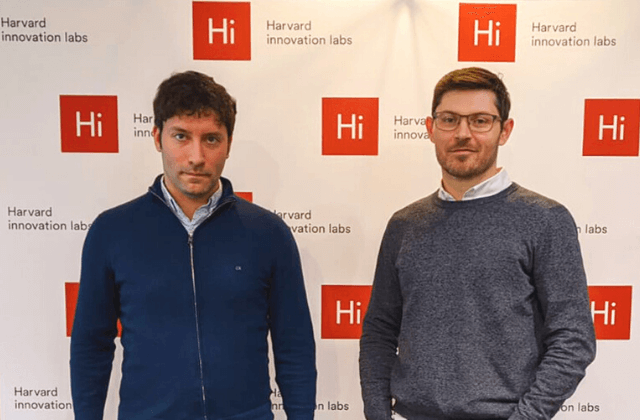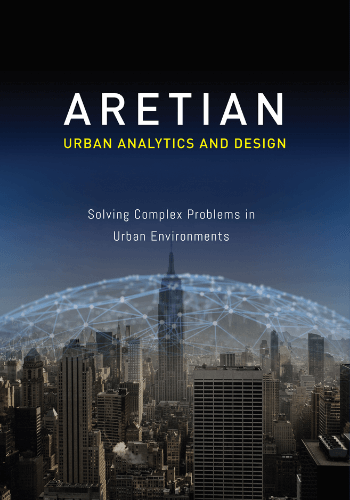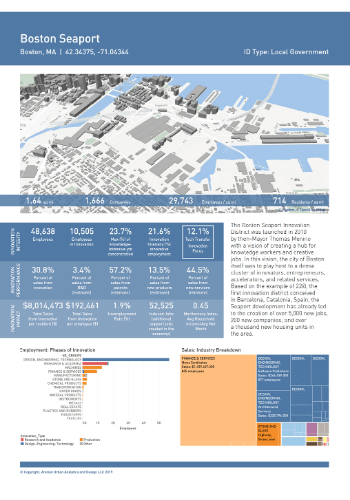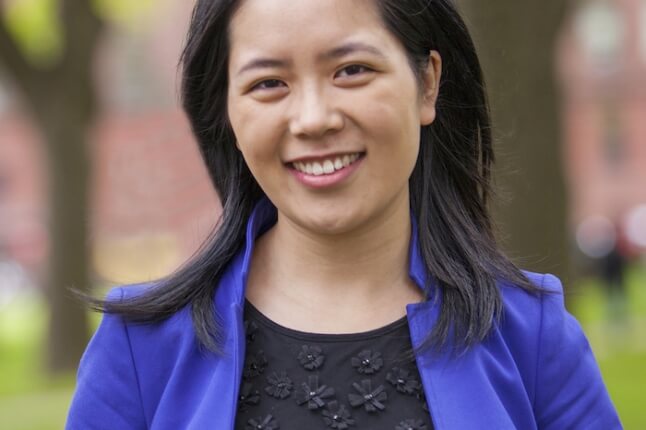News
Aretian co-founders Ramon Gras (left) and Jeremy Burke, 2018 graduates of the Master in Design Engineering Program, are using data analytics and machine learning to give planners insights into how a city works. (Photo courtesy of Jeremy Burke and Ramon Gras)
The dangers caused by thousands of drivers, cyclists, and pedestrians simultaneously navigating narrow streets can make even the most seasoned city dweller wonder what the urban planners were thinking.
If those officials knew how their decisions would impact residents and workers decades into the future, maybe they would have designed the city differently.
While there’s no such thing as a crystal ball, there is Aretian, a startup launched by two recent graduates of the Master in Design Engineering Program, offered jointly by the Harvard John A. Paulson School of Engineering and Applied Sciences and Graduate School of Design. Aretian uses data analytics and machine learning to give planners insights into how a city works, and help them zero in on the best design decisions to encourage smart growth.
“When a city is developing, they really only get one shot to develop the land. And when you design a new campus or building, you can’t iterate through designs and update buildings constantly,” said Jeremy Burke, M.D.E. ’18. “So having the largest amount of information available at the design process is critical to the long-term success of the project.”
The startup builds off an economic model that explains specific factors that enable certain nations to become prosperous. Aretian applies those principles to cities, or districts within cities, using data visualizations to show why some thrive economically while others don’t, explained Ramon Gras, M.D.E. ’18.
The startup offers tailored analytical tools to better understand urban- and metro-level problems. The company provides a diagnostic of the city’s current state and recommendations for decision-making, design criteria, investment allocation, and scenario planning.
“Very often, engineers and designers tend to approach a problem in isolation,” Gras said. “But since we analyze cities as a system, that can help clarify the role of a specific design intervention in the territory in terms of the broader system.”
Decisions have ripple effects. For instance, the locations of certain industries, the urban infrastructure that provides access to those industries, and the physical design of buildings can play a huge role in the ability of companies to attract skilled workers, which has broader economic implications.
The model can also be applied on a smaller scale, such as for campus operators who want to understand the ideal space configurations to foster collaboration, Burke said. Or it could show a real estate developer how industries change over time, revealing measures that could help clients effectively expand businesses.
This systems-level approach, coupled with the ability to compare trends across the U.S., makes Aretian unique.
Gras and Burke began exploring city data in the MDE program, where their backgrounds in urban planning led them into a joint thesis project.
“We had common interests in being able to address in a more systematic and rigorous way the problem of the future of work,” Gras said. “The risk of massive displacement of traditional employment opportunities as a result of automation, AI, and robotics concerns many people.”
The pair began seriously considering a startup after receiving positive feedback during their joint thesis defense. They launched Aretian in July.
Since then, the nascent company has consulted with several clients, including the Massachusetts Port Authority and the Barcelona Metropolitan Area (36 municipalities), while also bidding on projects in Santa Fe and Tarragona, Spain.
At the same time, Gras and Burke have been developing software, which would provide an urban analytics and design engine that incorporates machine learning and data visualization tools.
“We think the real value-add is in the creative analytics we provide for our clients. It is very powerful, the way data can be descriptive across different regions of the U.S., but that makes it critical to work with a specific community in a specific context to solve the problems they are facing,” Burke said. “We don’t want to just create a pure automation machine We want to have a strong and robust underlying platform on which we can share some services and ideas, but then also apply our analytical techniques on top of that.”
Now working out of the Harvard Innovation Labs, they are growing the team so they can devote more effort to software development
One of their biggest challenges is grappling with a growing amount of data. They must ensure their models are filtering that data properly, while also being robust enough to include static data sets and real-time information.
“It is also challenging to explain very complex modeling to a broader audience,” Gras said. “We need to adapt to different audiences in academia, public administration, and private companies, speak their languages, and use their jargon and lexicon.”
But despite the challenges, Gras and Burke are excited to dive deeper into a variety of thorny problems with real-world implications.
“Helping to raise the quality of urban design, and in turn having an impact on urban development, sustainability, economies, and quality of life, is very rewarding,” Gras said. “Our values are very much in line, not only with our passion for cities and urban design, but also the impact it can have. When a community is shaped a certain way, it makes the people who are living and working there happier.”
Topics: AI / Machine Learning, Entrepreneurship
Cutting-edge science delivered direct to your inbox.
Join the Harvard SEAS mailing list.
Press Contact
Adam Zewe | 617-496-5878 | azewe@seas.harvard.edu





